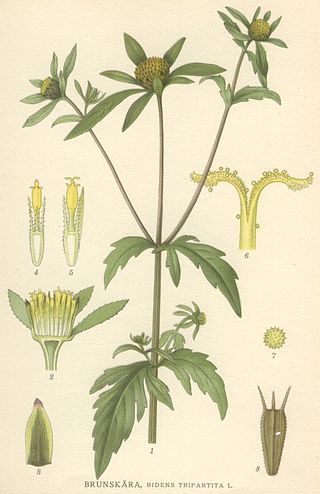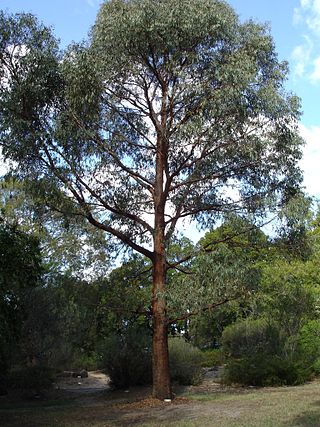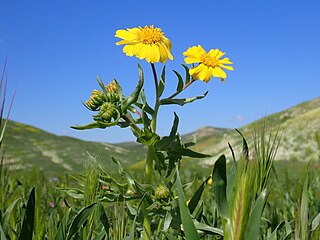
Pinus radiata, the Monterey pine, insignis pine or radiata pine, is a species of pine native to the Central Coast of California and Mexico. It is an evergreen conifer in the family Pinaceae.

Bidens is a genus of flowering plants in the aster family, Asteraceae. The genus include roughly 230 species which are distributed worldwide. Despite their global distribution, the systematics and taxonomy of the genus has been described as complicated and unorganized. The common names beggarticks, black jack, burr marigolds, cobbler's pegs, Spanish needles, stickseeds, tickseeds and tickseed sunflowers refer to the fruits of the plants, most of which are bristly and barbed. The generic name refers to the same character; Bidens comes from the Latin bis ("two") and dens ("tooth").

The mung bean or green gram is a plant species in the legume family. The mung bean is mainly cultivated in East, Southeast, and South Asia. It is used as an ingredient in both savoury and sweet dishes.

Vigna is a genus of plants in the legume family, Fabaceae, with a pantropical distribution. It includes some well-known cultivated species, including many types of beans. Some are former members of the genus Phaseolus. According to Hortus Third, Vigna differs from Phaseolus in biochemistry and pollen structure, and in details of the style and stipules.

Bidens frondosa is a North American species of flowering plant in the aster family, Asteraceae. It is widespread across much of Canada, the United States, and Mexico It is known in many other parts of the world as an introduced species, including Europe, Asia, Morocco, and New Zealand. Its many common names include devil's beggarticks, devil's-pitchfork, devil's bootjack, sticktights, bur marigold, pitchfork weed, tickseed sunflower, leafy beggarticks, and common beggar-ticks.

Aulonemia is a genus of bamboo in the grass family. It is native to Central America and tropical South America.

Lycoris is a genus of 13–20 species of flowering plants in the family Amaryllidaceae, subfamily Amaryllidoideae. They are native to eastern and southern Asia in China, Japan, southern Korea, northern Vietnam, northern Laos, northern Thailand, northern Burma, Nepal, northern Pakistan, Afghanistan, and eastern Iran. They were imported into North Carolina and now grow wild. In English they are also called hurricane lilies or cluster amaryllis. The genus shares the English name spider lily with two other related genera.

Mackinlaya is a genus of flowering plants in the family Apiaceae, native to Malesia, Papuasia and Australia. It was formerly placed in Araliaceae.

Eucalyptus radiata, commonly known as the narrow-leaved peppermint or Forth River peppermint, is a species of tree that is endemic to south-eastern Australia. It has rough, fibrous to flaky bark on the trunk and larger branches, smooth grey bark on the thinner branches, lance-shaped to curved or almost linear leaves, flower buds in groups of eleven to twenty or more, white flowers and cup-shaped, hemispherical or shortened spherical fruit.

Antirhea is a genus of flowering plants in the family Rubiaceae.

Utricularia inflata, commonly known as the swollen bladderwort, inflated bladderwort, or large floating bladderwort, is a large suspended aquatic carnivorous plant that belongs to the genus Utricularia. It is a perennial that is native to the southeastern coastal plains of the United States. It has often been confused with U. radiata, which is similar but smaller than U. inflata. Since 1980, U. inflata has been reported to exist in locations beyond its traditional range, such as the Adirondack Mountains in New York, southeastern Massachusetts, and in Washington State. Studies on the populations in the Adirondacks suggest that an introduction of U inflata. to a location where it naturalizes can lead to altered sediment chemistry by reducing the net primary productivity of native species. It is also listed by the state of Washington as a problematic species because of the dense mat-forming habit of this aquatic Utricularia. It is one of the few carnivorous plants that can be invasive.

Lycoris radiata, known as the red spider lily, red magic lily, corpse flower, or equinox flower, is a plant in the amaryllis family, Amaryllidaceae, subfamily Amaryllidoideae. It is originally from China, Japan, Korea and Nepal and spread from there to the United States and elsewhere. It is considered naturalized in Seychelles and in the Ryukyu Islands. It flowers in the late summer or autumn, often in response to heavy rainfall. The common name hurricane lily refers to this characteristic, as do other common names, such as resurrection lily; these may be used for the genus as a whole.

Nomen illegitimum is a technical term used mainly in botany. It is usually abbreviated as nom. illeg. Although the International Code of Nomenclature for algae, fungi, and plants uses Latin terms as qualifiers for taxon names, the definition of each term is in English rather than Latin. The Latin abbreviations are widely used by botanists and mycologists.

Madia radiata is a species of flowering plant in the family Asteraceae known by the common names golden madia and showy madia. It is endemic to California, where it is known mostly from the Central Coast Ranges and adjacent edges of the San Francisco Bay Area and Central Valley.
Richterago radiata is a species of flowering plant in the family daisy family. It is native to Brazil.

Bidens aristosa, known by many common names such as bearded beggarticks, western tickseed, showy tickseed, long-bracted beggarticks, tickseed beggarticks, swamp marigold, and Yankee lice, is an herbaceous, annual plant in the Asteraceae family. It is native to the central United States, but has been introduced to the eastern United States, Canada, France, Great Britain, and India. It grows in marshes, meadows, pine forests and disturbed sites.

Valeriana woodsiana, common name beaked cornsalad, is a plant native to the United States. It is an annual self pollinating flowering plant and besides being edible there are no known uses. Valerianella radiata flowers from April- May.

Carex radiata, the eastern star sedge, is a species of flowering plant in the family Cyperaceae, native to central and eastern North America. It is cultivated for its yellowish-green foliage and its relatively—for a sedge—showy flowers.

Hyoseris radiata is a species of herb in the family Asteraceae. They have a self-supporting growth form and broad leaves. Individuals can grow to 23 cm.

















